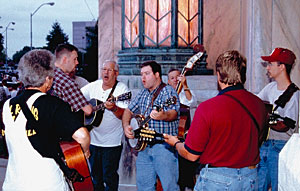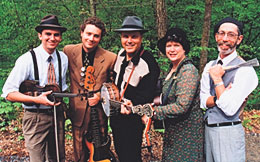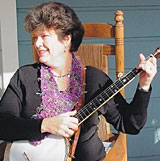
External play: Informal jams are as much a part of Shindig on the Green as the singers and dancers who perform on stage. Construction at City/County Plaza this summer may threaten this portion of the decades-old event.
|
“There’s a reason why Asheville is a center of mountain music,” reveals historian and Grammy-winning musician David Holt. “It’s because Bascom [Lamar Lunsford] started the Mountain Dance and Folk Festival here.”
Vintage-folk singer Laura Boosinger agrees, though she has her own ideas about the inaugural date of the event. “Bascom started this festival in 1927,” she insists. Sure, if you read the festival’s official history, the date is 1928, but Boosinger, a stickler for accuracy, stands firm.
“I’ve been told 1927 because that’s the first time he held it at his house. Nineteen-twenty-eight was the first time he brought it downtown,” she clarifies.
And really, that’s what counts. Shindig on the Green — the summer-long offshoot of the Mountain Dance and Folk Festival — is a “natural form of entertainment — taking [music] from the front porch to the city’s front porch,” Boosinger intones.
Simply put, Shindig happened because mountain musicians who came down to the valley wouldn’t be silenced. So into jamming were they that, come the wee hours, instead of packing up their instruments and heading home, they just moved the party to the Westgate parking lot. By the 1960s, city officials realized these impromptu jams deserved a place downtown. The budding event’s tourist-attracting potential wasn’t far from officials’ minds, either, and soon enough the family-friendly weekly event fell into full swing.
” … It’s important to keep it downtown,” Boosinger says. And she, along with Holt and the Steep Canyon Rangers, will play an April 16 benefit to make sure that’s exactly what happens.
Myths of Shindig, debunked
First things first: Shindig isn’t moving.
“We’ll have to make some adjustments with the [plans for expansion] that are coming to City/County Plaza,” explains local Heritage Development Officer Leesa Brandon. (Changes may include decreased space for Shindig’s notorious informal jams.)
Anyone who’s driven down College Street toward Town Mountain lately has encountered the early stages of construction in that area. But even a temporary relocation doesn’t mean a new home for the decades-old event.
Brandon sets the record straight: “We have no plans to move [permanently].”
And now for a second revelation: Shindig on the Green isn’t free. Well, there’s no admission charged for fans — but putting on the seven or eight annual shows does carry a price tag: about $3,000 a night.
“[Costs] have been going up,” Brandon points out. “The crowds keep getting bigger, so we need more Portajohns and a better sound system so everyone can hear what they want to hear. We also pay a house band for the summer” (not to mention maintaining an office and a Web presence).
Currently, Shindig runs on corporate contributions and on the net of small fundraisers such as raffles, but the Folk Heritage Committee (a component of the Asheville Convention and Visitors Bureau), in looking for ways to involve the community more, hit on the idea of a benefit concert.
So, for the second year, mountain-music stars will take to the stage for that purpose. And that’s where David Holt & the Lightning Bolts, Laura Boosinger and the Steep Canyon Rangers step into the picture.
Heritage before it was cool

David Holt and the Lightning Bolts
|
“Music is in everybody’s soul,” says Holt. “These old songs have soul in them. They’re part of our mountain culture — part of who we are.”
If you’ve caught him picking a tune with 91-year-old Piedmont-blues guitarist Etta Baker on his UNC-TV show Folkways, or listened to Legacy (High Windy), his 2002 Grammy-winning release with guitar legend Doc Watson, you’d probably agree that Holt’s an expert of sorts on the mountain medium.
No, he’s not from around here — but he got here early, in the 1960s, when an inquisitive young songcatcher could still find “a lot of old-timers who’d learned the music from the 1800s, before they were affected by the mass media,” Holt notes. Born in Texas, he was drawn to Asheville for the tunes. “I got into it as a 19-year-old, and I’ve been doing it 100 percent ever since.”
Back in the day, “folks who became really skilled at something like music were usually quite intelligent and deep thinkers,” he reflects. “We live in a pop culture now: We’re affected by very superficial things. Those people weren’t.”
But, in the face of a media-saturated and fusion-happy society (think newgrass, jazz-grass, Appalachian reggae), why work so hard to keep mountain music not only alive but pure?
“I really do feel a strong responsibility to present this music and culture to people so they get a real impression of what it is, instead of a Hollywood impression,” says Boosinger. “Kids need to know it’s their heritage — it’s not archaic.”
According to Boosinger, “way before it was popular, before O Brother, Where Art Thou? and all, we in Western North Carolina, above all other people in the country, figured out our traditions were important to save.”
In fact, Boosinger’s view is as old as the old-timers Holt sought out: The drive to save local music traditions goes back to that controversial year 1928 (or was it 1927?).
Miss Rhododendron, go home!

Laura Boosinger
|
“We’ve always had to convince people this was a good thing to do,” Boosinger notes. “Not so much now — but there was a time when the city didn’t want to promote itself as a ‘hillbilly’ destination.” (This, obviously, predates the Mountaineer Inn on Tunnel Road, with its gaudy, oversized hillbilly cutouts swilling ‘shine and sporting patched overalls.)
Nearly 80 years ago, the Chamber of Commerce geared up for its Rhododendron Festival “to call attention to the beauty and climate of what the promoters had taken to calling the ‘Land of the Sky,'” Loyal Jones wrote in Minstrel of the Appalachians: The Story of Bascom Lamar Lunsford. Complete with beautiful-baby contests, handicrafts displays and a “Miss Rhododendron” pageant, the event was geared toward drawing tourists to the up-and-coming mountain city.
The Chamber approached Lunsford about planning a song-and-dance program, and he responded with “five square dance clubs to compete for prizes and invited ballad singers, fiddlers, banjo pickers and string bands to entertain on Pack Square,” writes Jones.
The passage continues: “Five thousand people descended upon downtown Asheville and were backed up against office buildings, draped across Zeb Vance’s statue and hanging out of the windows of local businesses.”
In fact, the song-and-dance part of the fete was such a smash that, while no one’s heard from Miss Rhododendron since, the Mountain Dance and Folk Festival, as it became, is now in its 77th year. Traditionally occurring the first weekend in August, it is the country’s longest continuously running folk festival.



My wife and I plan to be in the Asheville Area the first week-end in July. I am a relatively new dobro player and would love to “jam” with some of the people who come to play under the trees. We have attended Shindig on the green in times past. Question–is this jamming limited to local folks or is a visitor welcome to join in? Thanks for your reply.
Don Doggett
The Villages, FL